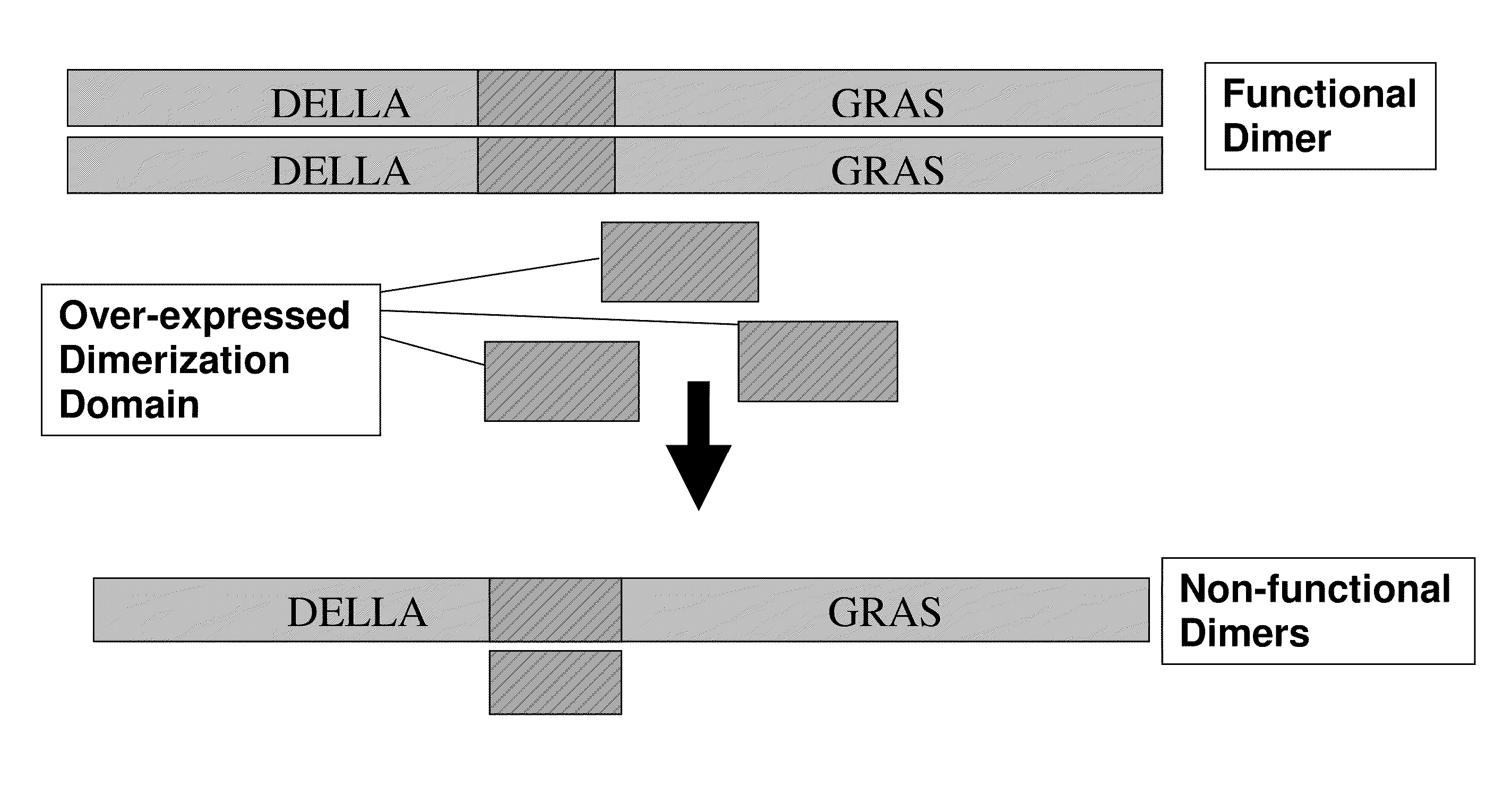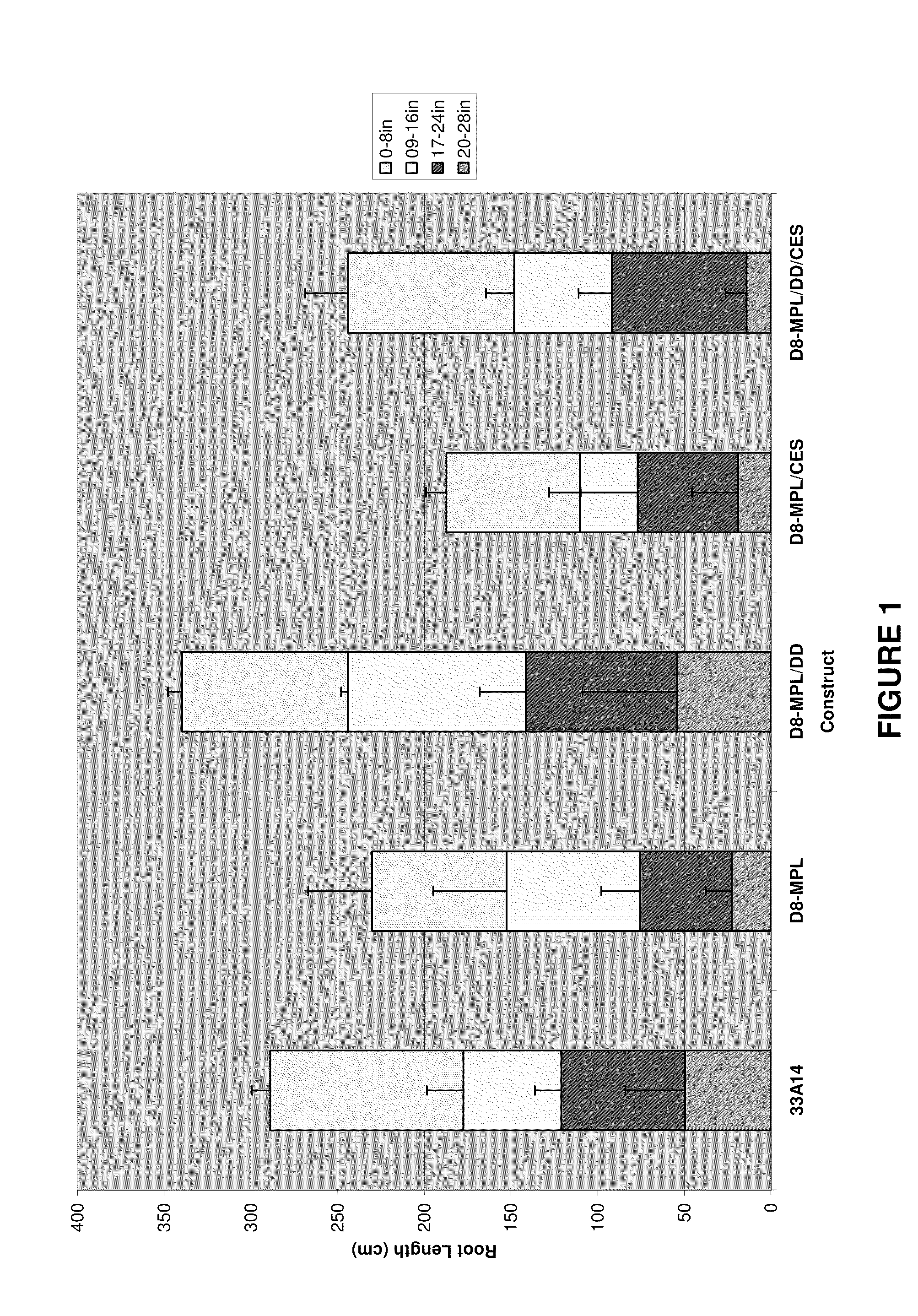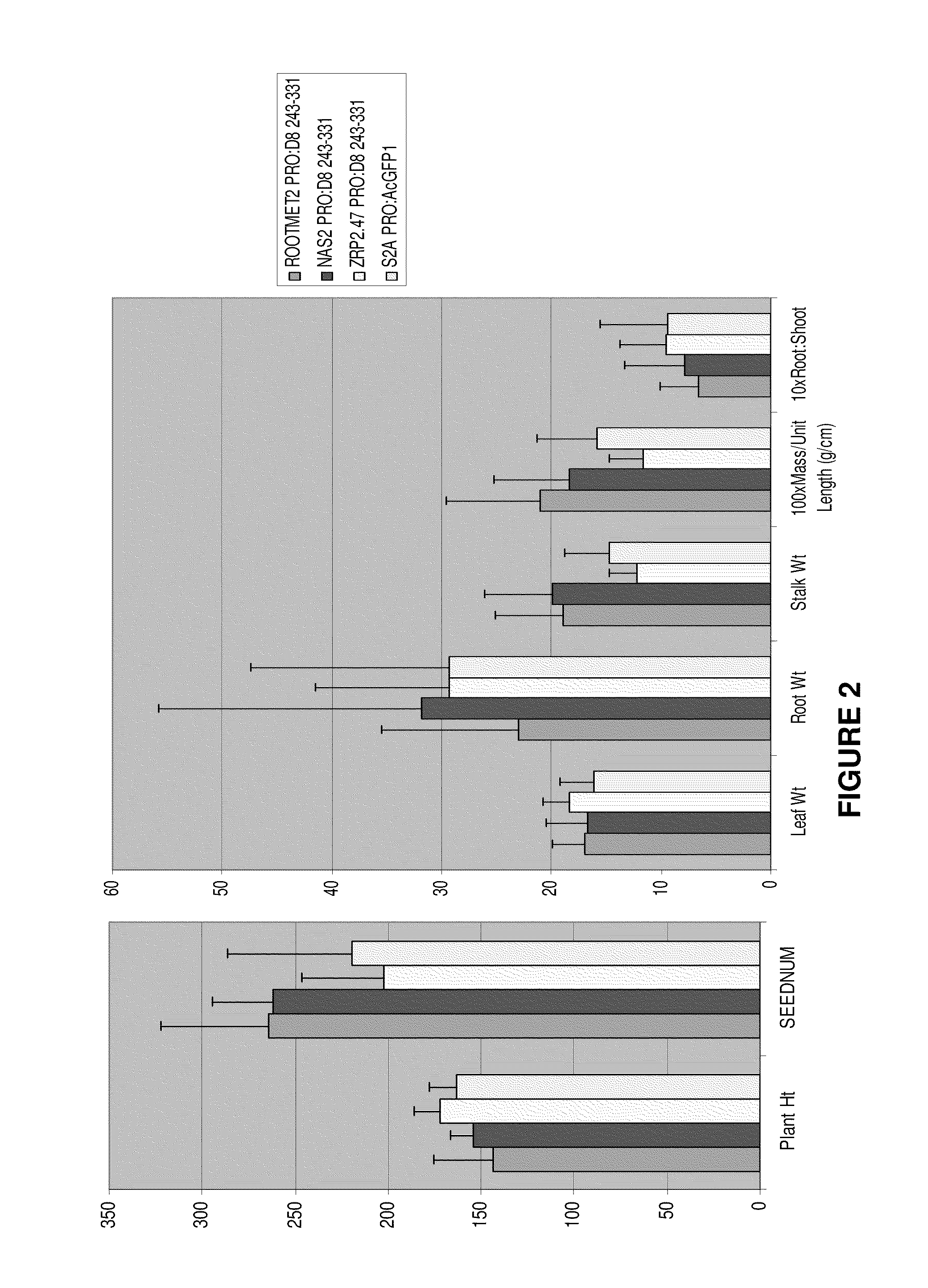Use of dimerization domain component stacks to modulate plant architecture
a technology of dimerization domain and component stack, applied in the field of molecular biology, can solve the problems of increasing the frequency of stalk and root lodging, and achieve the effects of increasing or decreasing the level of a dimerization domain component stack polypeptide, increasing the yield of plants, and increasing the grain yield of cereals
- Summary
- Abstract
- Description
- Claims
- Application Information
AI Technical Summary
Benefits of technology
Problems solved by technology
Method used
Image
Examples
example 1
Yield and Harvest Index Tests—RT810ZBS_T (Intro-EF09B / GR1B5)
[0222]PHP26963 (S2a:D8MPL+S2a:CesA10)—10 evts[0223]PHP26998 (S2a:D8mpl+Nas2:DD+S2a:CesA10)—8 evts[0224]PHP24843 (S2a:D8MPL+NAS2:DD)—4 evts[0225]Construct Nulls (3 events / null)[0226]WT (Intro-EF09BZTZ / GR1B5)
2 Densities
[0227]36,000 PPA (JH, MR)—Yield (5 reps)[0228]48,000 PPA (JH, MR)—Yield (5 reps), Harvest Index (3 reps)
[0229]Three constructs were tested at Johnston (JH) and Marion (MR) Iowa at two densities, 36,000 plants per acre (PPA) and 48,000 PPA in 20″ row width. The genes tested consisted of the dwarf mutant D8mpl and the additional genes (stacks) DD (dimerization domain of the D8 gene) or the Ces A10 gene. The constructs are shown below in which the transgenic events are shown with their plasmid identification and nulls (segregating non transgenic sibs) are shown with their plasmid designation and the letter n.
TABLE 2D8mpl + DDphp24843 E7216.51.1.1php24843nE7216.49.1.5D8 + CesA php26963E7216.49.2.1php26963E7216.49.2...
example 2
Yield and Harvest Index Tests—(Intro-EF09B / HG11)
[0233]Topcrosses were made from PHP26963, PHP26998 and PHP24843 T0 plants onto HG11 females. This produced a background genotype similar to commercial hybrid 33A14 which could be used as a reference. These plants were then grown in Johnston observation plots. A small planting of PHP17881 hybrids were also included.[0234]PHP26963 (S2a:D8MPL+S2a:CesA10)—2 evts, 6 rows[0235]PHP26998 (S2a:D8mpl+Nas2:DD+S2a:CesA10)—2 evts, 6 rows[0236]PHP24843 (S2a:D8MPL+NAS2:DD)—2 evts, 8 rows[0237]PHP17881 (S2a:D8MPL)[0238]WT (EF09B / HG11-33A14)—11 rows
Minirhizotron tubes were inserted in the soil near these plants to allow for imaging of roots that intersected the tubes. This allowed for a direct measurement of root length of the NAS2:DD stack constructs (FIGS. 2-5). The DD stacks had longer root systems at earlier time points and appeared to be colonizing the soil more rapidly than the non DD counterparts. The later time point showed the non-DD construct...
example 3
Greenhouse Grown Transgenic Stacks
[0239]Three constructs were tested in the introEF09B background at the T0 generation to determine the agronomic characteristics of the D8 dimerization domain stacks and for preparation for field testing. Each stacked construct (PHP24843, PHP26963 and PHP26998) utilized the S2A PRO:D8MPL gene, NAS2 PRO:D8 243-331 and / or S2A PRO:ZM-CES A10.
[0240]Genes Tested (Intro EF09B)[0241]S2a:D8MPL (Vascular Element Preferred Promoter:moderate dwarfing Gene)[0242]Nas2:DD (Root Preferred Promoter: Leucine Zipper Dimerization Domain)[0243]S2a:CesA10 (Vascular Element Preferred Promoter:Cellulose Synthase Gene in Stalk Tissue.
[0244]Gene Combinations (“Stacks”) of Two and Three Genes[0245]PHP24843—NAS2 PRO:D8 243-331 / S2A PRO:D8MPL Stack (13 events)[0246]PHP26963—S2A PRO:ZM-CES A10 / S2A PRO:D8MPL Stack (15 events)[0247]PHP26998—NAS2 PRO:D8 243-331 / S2A PRO:ZM-CES A10 / S2A PRO:D8MPL (14 events)
[0248]Morphometric analyses were performed on the mature T0 plants from this ex...
PUM
| Property | Measurement | Unit |
|---|---|---|
| temperature | aaaaa | aaaaa |
| temperature | aaaaa | aaaaa |
| pH | aaaaa | aaaaa |
Abstract
Description
Claims
Application Information
 Login to View More
Login to View More - R&D
- Intellectual Property
- Life Sciences
- Materials
- Tech Scout
- Unparalleled Data Quality
- Higher Quality Content
- 60% Fewer Hallucinations
Browse by: Latest US Patents, China's latest patents, Technical Efficacy Thesaurus, Application Domain, Technology Topic, Popular Technical Reports.
© 2025 PatSnap. All rights reserved.Legal|Privacy policy|Modern Slavery Act Transparency Statement|Sitemap|About US| Contact US: help@patsnap.com



